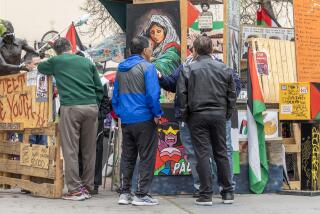Temple Achieves Measure of Peace in Hacienda Heights
- Share via
Man Tao, 35, a Buddhist nun from Malaysia, slowly enunciated the foreign words: “Como esta usted?”
“Como se llama?”
She giggled shyly while taking a break from welcoming a steady stream of visitors to the Hacienda Heights temple and bowed her shaved head after demonstrating what she had learned in three months of Spanish classes at Hsi Lai Temple.
“Perhaps one day I’ll have the chance to connect with the Spanish-speaking people and give them the Buddha’s teaching,” Man Tao said.
A collection of awe-struck sightseers, devout worshipers and curious passers-by is a common sight to Man Tao and the 30 other nuns and monks-in-residence at the monastery, the largest of its kind in the Western Hemisphere and one of more than 50 branches of Fo Kuang Shan, Taiwan’s predominant Buddhist organization.
“Beautiful,” sighed Husteon (Chick) Price, 72, a West Los Angeles resident visiting for the first time with his wife, Dorothy, and a Thai neighbor, Nilla Kronprasert. “I’ve read about this in the paper. It’s just beautiful.”
Outside, a group of art students from Mt. San Antonio College in Walnut milled around the central courtyard of the 15-acre complex, admiring the glistening ocher tile roofs, gilded sculpture and intricate stone carvings. Nuns scurried from one building to another, offering hot tea to visitors.
A solemn-faced Asian woman entered the Hall of Buddha, knelt on the tile floor and prostrated herself before three seven-foot-high fiberglass statues of the smiling deity, enveloped in a cloud of jasmine incense.
As Hsi Lai Temple prepares to mark its second anniversary next month, spiritual leaders there are more than just religious mouthpieces and strict adherents of the eight precepts, or Buddhist commandments. Over the last two years, they also have served as ministers of culture to residents in the ethnically diverse community.
Spanish classes are conducted in Chinese for the benefit of immigrants from Taiwan, China and Hong Kong who work side by side with newcomers from Mexico and Central America.
Earlier this year, the temple helped establish a sister school relationship between Nogales High School in La Puente and P’u Men High School at the Fo Kuang Shan Temple in Taiwan.
At the end of each month, the temple holds an “Eight Precepts Retreat” to teach lay people the basics of Buddhism.
As many as 100 participants file into the Hall of Buddha and learn how to chant, prostrate before the deity and repent their bad deeds. They are served two vegetarian meals and, at the end of the day, sleep on floors in the monastery’s living quarters, in accordance with a Buddhist teaching that followers of the religion forgo luxury. (Nuns and monks at Hsi Lai sleep on simple cots, Man Tao said.)
Such is the rhythm of life at Hsi Lai--not a rhythm that came easily to the Hacienda Heights temple. When the Buddhists first proposed the project 10 years ago, Hacienda Heights residents opposed it, showing up en masse before the Los Angeles County Board of Supervisors to object to the temple’s large size and the number of people and cars it would attract. Some feared the nuns and monks would startle neighbors with pre-dawn gongs and loud chanting.
Last year, after 2,000 visitors descended on the temple during Chinese New Year, residents complained about illegally parked cars and traffic pouring onto Hacienda Boulevard. Supervisor Pete Schabarum warned temple officials that the large crowd violated a conditional-use permit. The county erected no parking signs on the street.
In addition, fire officials said lighted niches with tiny statues of Buddha lining the walls of the main temple did not meet safety codes and would either have to be removed or protected with a sprinkler system. The temple opted for the latter.
Nowadays, there are fewer complaints, mostly concentrated in the residential area surrounding the temple complex on Glenmark Drive.
“It’s in the wrong location,” said Sharon Pluth, who lives on Thaxton Avenue a few blocks north of the monastery. “They made it into a tourist attraction. I would have fought just the same if they wanted to put Disneyland in my community.”
Besides being a religious and cultural center, Hsi Lai Temple has become a stopping-off point for Chinese students and scholars who have defected to the United States. Since the June 4 military crackdown on pro-democracy protesters in Beijing’s Tian An Men Square, participants in the movement, including student leader Wuer Kaixi, have sought temporary refuge at the temple.
More recently, Xu Jiatun, China’s former top representative to Hong Kong whose departure from the British colony was the subject of widespread media speculation that he was planning to seek asylum in the United States, turned up in Southern California under the care of Hsi Lai’s founder, Master Hsing Yun.
Xu reportedly had fallen out of favor with Chinese Premier Li Peng for being sympathetic to the democracy movement. Last month, Hsing held a press conference at the temple to dispel rumors of Xu’s defection. Hsing said the 74-year-old Xu was merely vacationing and intended to return home.
In a recent interview, Hsing said his willingness to house Xu, Wuer and others was merely a humanitarian gesture, which he would extend to people of all faiths and cultures. He added that he shied away from mixing religion and politics when he refused a request by Chinese community leaders to hold a ceremony at Hsi Lai Temple in commemoration of those killed in Tian An Men Square.
“They have their political ideals, we have our own ideals of compassion and loving kindness,” Hsing said through an interpreter. “For example, if a mother is beating her child, and the child is taken in by a third person, the mother would not have misunderstandings and blame the person for taking care of her child.”
More to Read
Sign up for Essential California
The most important California stories and recommendations in your inbox every morning.
You may occasionally receive promotional content from the Los Angeles Times.










